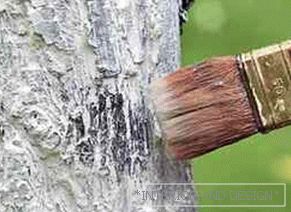 Almost any garden grows any trees: apples, pears, non-fruit trees. They, like any other plants in the garden, require care. One of the important elements of this care is whitewashing. In this article we will consider when and in what ways to produce whitewashing of different trees.
Almost any garden grows any trees: apples, pears, non-fruit trees. They, like any other plants in the garden, require care. One of the important elements of this care is whitewashing. In this article we will consider when and in what ways to produce whitewashing of different trees.
Content
- 1 When to whitewash the garden
- 2 Purpose
- 3 Preparation of trees
- 4 Whitewash
- 5 General recommendations
When to whiten the garden
When to whiten the trees: in autumn or spring, it’s up to the landlord to decide. There is no single opinion on this. However, in general, experts recommend to whiten the trees on the site 2-3 times a year:
- the main one is autumn (October - November);
- spring - spring (end of February - beginning of March);
- optional (midsummer).
The most effective is the whitewashing of trees in the fall. However, if for any reason whitewashing of apple trees in the fall was missed, in the spring, as soon as the temperature permits, a treatment should be carried out. If a spring renewal procedure is carried out in the spring, then it can be done at a later date (March - April).
The third summer painting is optional, however, it is desirable if the summer is rainy and the composition is strongly washed off from the bark.
Purpose
Fruit trees in the garden is desirable to whiten twice a year: autumn and spring.
-
 Whitewashing apples and pears can destroy a huge number of insects and fungi that live and infect the bark. This prevents the development of various diseases and contributes to a more abundant harvest.
Whitewashing apples and pears can destroy a huge number of insects and fungi that live and infect the bark. This prevents the development of various diseases and contributes to a more abundant harvest. - Autumnal whitewashing of apple trees will also protect them from burns, most of which are obtained by trees in early spring or winter. White trunks well reflect the sun's rays, which helps protect trees from overheating and cracking of the bark. In winter, due to temperature drops, the crust can crack, and the compound protects and prevents this danger.
- In addition, the autumn whitewash will scare off rodents, who in the winter are not averse to damaging the young trunks of seedlings.
Tree preparation
Before whitewashing, the plants must be prepared for processing. Apple trees and other fruit trees cook in several stages.
The first stage - cleansing the trunk and branches. Cleansing is best done in wet weather. Moss, lichens and remnants of old exfoliated bark are removed from the apple trees. To use any tools for this is not necessary, it is enough to remove what is cleaned by hand. To clean the cracks and grooves on the trunk, you can use a wooden stick. Everything cleaned from the trees must be burned so that there are no accumulations of pests and diseases in the area. The cleaned material will be easy to collect if you lay a film or fabric under the trees before the procedure.
The second stage is the treatment of wounds. Disinfection of the bark requires that the weather is dry for 2–3 days, otherwise the result will be zero. Exists several processing options:
- a solution of copper-containing drugs: the treatment is carried out by fine spraying, creating a misty curtain around the tree trunk and allowing the composition to settle on the bark. The most popular substances are copper sulphate and Bordeaux mixture;
- ash or ash-soap extract, which is obtained from ashes dissolved in hot water and soap. Processing is carried out with rags;
- Ash liquor, which is obtained from ash and water, the treatment is carried out and spraying and washing the apple trees.
Be sure to take precautions when disinfecting bark: wear gloves and a respirator.
The third stage - wound repair. After scrubbing and plucking dry twigs and dead bark, there are wounds in the trees that need to be repaired. There are several putties for this:
- clay mash;
- garden pitch;
- garden paste "RunNet".
Whitewash
 The composition also plays a significant role. What to choose depends on the purpose of whitewashing, on the time of processing the trees and the condition of the trees in the garden, and on personal preferences.
The composition also plays a significant role. What to choose depends on the purpose of whitewashing, on the time of processing the trees and the condition of the trees in the garden, and on personal preferences.
Lime based whitewash. Its main advantage is that it does not require independent cooking. However, in this its and minus - such compositions do not differ in durability. After a couple of spring rains from the whitewashing on the trunks will not remain a trace.
Paint (acrylic or water-based). Typically, such compounds enrich the antifungal drugs that create a film around the plant and prevent the development of various diseases. The main disadvantage of such whitewashing is that it does not breathe, therefore it can only be used on mature trees.
Lime-based whitewash. The most popular and cheap formulations. It is better to whiten apple trees with such compositions in two layers so that the composition holds better. However, despite its popularity, this mixture does not have a very high degree of protection. To improve the disinfecting properties of such mixtures add clay and manure. If there are already mature plants on the site, then glue is added to the mixture to enhance adhesion to the bark.
So what to use for whitewashing trees in the fall? The composition can be any, the main thing is the main three components:
- white dye;
- viscous adhesive component;
- disinfectants.
General recommendations
 For whitewashing use a brush to fit the thickness of the apple trees in the garden. This allows more sparing paint on the trunk. If there is an opportunity not to save much, then you can use the spray gun.
For whitewashing use a brush to fit the thickness of the apple trees in the garden. This allows more sparing paint on the trunk. If there is an opportunity not to save much, then you can use the spray gun.
Before the whitewash begins, the ground around the tree is slightly folded back and starts to whiten 3-4 cm below ground level. Subsequently, after drying the whitewash, the removed soil is returned to the place. Carefully stain not only the trunk of the tree, but also the base of the branches 20–30 cm higher than branches.
Usually whiten apple trees that have already begun to bear fruit. Younger apple trees are not recommended to touch in order not to clog the pores and not to disturb their growth.
It should also be added that the work on the staining of the trunks is carried out in dry, calm weather in order for the whitewash to dry and consolidate.



